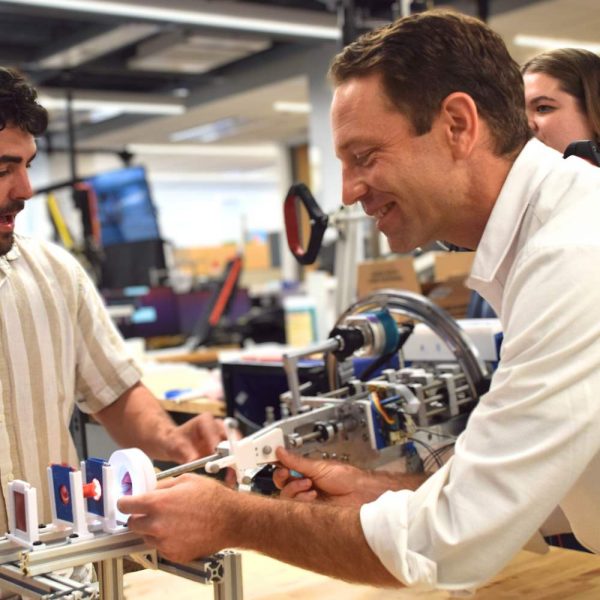A surgical robot capable of performing an entire surgery without human intervention: That's the goal of a landmark, multi-institution project being led by a Vanderbilt engineer that recently received an award up to $12 million in funding from the Advanced Research Projects Agency for Health (ARPA-H).

Robert J. Webster, the Richard A. Schroeder Professor of Mechanical Engineering, will lead a team that includes robotics experts from the University of Utah, Johns Hopkins University, Vanderbilt, as well as surgeons from Vanderbilt University Medical Center, to develop the breakthrough technology. The team also includes hardware and software experts from Virtuoso Surgical, a surgical robotics company co-founded by Webster and Duke Herrell, professor of urology and Director of VUMC's Minimally Invasive Urologic Surgery/Robotics Program.
"Fully autonomous surgical robots will transform medicine," Webster said. "Not only will they make routine procedures safer and more affordable, but they will also address the worldwide shortage of surgeons and expand global access to lifesaving surgeries."
Current surgical robotic technologies rely on one of two automation techniques. The first is known as model-based automation in which procedure sequences and start-stop conditions are pre-programmed. Another method draws on machine-learning algorithms requiring enormous datasets of procedures and task sequences. While each approach has led to advances in surgical robotics, both lack scalability, generalizability and adaptability.
"We will create brand new machine-learning algorithms beyond anything that exists today," Webster said. "The key to making them practical is to simultaneously look at how human surgeons perform their work. What basic set of maneuvers do they use? How do they sequence those maneuvers? The answers to these questions enable effective learning on a tractable amount of data."
Within three years, the research team hopes to demonstrate a robotic surgical device capable of removing tumors from the trachea and prostate without the intervention of a surgeon. The team also foresees this research applying to uterine fibroids, bladder tumors, spine procedures, and brain cysts, among other clinical applications. As described in the ARPA-H proposal, these would initially be demonstrated in simulated conditions and not on live patients.

The team will use needle-sized, concentric-tube robots capable of bending-which were developed at the Vanderbilt Institute for Surgery and Engineering (VISE)-to enable greater sensing abilities in fully autonomous devices. This enhanced perception, Webster explained, will transform a robot's understanding of its environment and surgical context.
"Physical touch … is the key to dramatically enhancing the robot's situational awareness, and ultimately automating surgery," Webster and the team wrote in the funding proposal.
Webster said one of the progress milestones will involve having the robot make situationally aware statements like, "I think I should cut here, with the goal of removing this volume of tissue." A human surgeon would then confirm or adjust the action. These interactions will be aggregated to continue to improve robotic performance to the point of fully independent autonomy.
"Creating a system that can learn from human surgeons - and continue to improve performance - will be a game changer," Herrell said. "Our vision is not to replace surgeons, but to vastly expand the work they do to improve patient's lives and long-term health outcomes."

Webster and Herrell have developed a highly collaborative research partnership through VISE, integrating engineering technology with clinical insights from experienced physicians.
"This ARPA-H award is a remarkable testament to the recognized excellence and impact of Vanderbilt School of Engineering in Surgical Robotics," said Krishnendu Roy, Bruce and Bridgitt Evans Dean of Engineering. "Professor Webster and the team exemplify the 'One Vanderbilt' principle through deep collaborations between Engineering and Medicine to develop transformative innovations that impact patient lives."
Padma Raghavan, vice provost for research and innovation and chief research officer, said the project showcases Vanderbilt's leadership in developing technologies that can change the future of healthcare.
"With this significant support from ARPA-H, Bob Webster and his team will bring about transformative autonomy in surgical robotics with minimal invasiveness to accelerate patient recovery," Raghavan said.
Ferdinando Rodriguez y Baena, professor of medical robotics at Imperial College London and co-director of the Hamlyn Centre, has been following Webster's work and said he can't think of a better team to bridge the gap between state-of-the-art robotic systems and the level of intelligent automation seen in other fields, which he said is lacking in surgical robotics.
"The mix of model-based and AI approaches, coupled with platform technologies that work at the small scale of concentric-tube robots, spearheaded by Bob from the onset, sounds like a winning recipe," Rodriguez y Baena said. "I eagerly look forward to seeing where this takes our field next! This is an incredible opportunity for the U.S. and this team to make a significant advancement in this technology for the better!"
This ARPA-H proposal was supported by Vanderbilt University Research Development and Support, which offers proposal development assistance for private (foundation) and federally funded opportunities. RDS is housed within the Office of the Vice Provost for Research and Innovation.
Watch:






